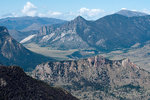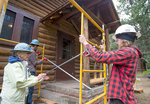Clear, 52° F
For years, maintenance to historic buildings at the Sunlight and Crandall ranger stations have been put off due to the lack of funding. Now, with the funds in hand, Shoshone National Forest crews and …
This item is available in full to subscribers.
The Powell Tribune has expanded its online content. To continue reading, you will need to either log in to your subscriber account, or purchase a subscription.
If you are a current print subscriber, you can set up a free web account by clicking here.
If you already have a web account, but need to reset it, you can do so by clicking here.
If you would like to purchase a subscription click here.
Please log in to continue |
|




For years, maintenance to historic buildings at the Sunlight and Crandall ranger stations have been put off due to the lack of funding. Now, with the funds in hand, Shoshone National Forest crews and volunteers are hard at work in what they have termed the First Forest Initiatives.
The funding arrived thanks to the popular 2020 bipartisan Great American Outdoors Act. Now, the Shoshone and Bighorn national forests are able to do some much needed maintenance, including roads, bridges and historic structures.
The landmark conservation legislation is using revenues from energy development to provide up to $1.9 billion a year through 2025 to provide needed maintenance for critical facilities and infrastructure in national parks, forests, wildlife refuges, recreation areas and American Indian schools. It will also use royalties from offshore oil and natural gas to permanently fund the Land and Water Conservation Fund to the tune of $900 million a year to invest in conservation and recreation opportunities across the country.
One high priority project is refurbishing a historic cabin at the Crandall Ranger Station. Built in 1936, the cabin is currently used to house seasonal employees, which is a crucial component for maintenance work needed in the forest.
“When it was built, the district ranger lived there with his family year round. So this is part of continuing that tradition of having Forest Service personnel living on the forest. That’s really something that we’re pretty proud of,” said Shoshone spokesperson Kristie Thompson.
The beautiful cabin had fallen into disrepair, she said.
“The work will be complete next year. Then, in the summer of 2024, we will begin the work at Sunlight Ranger Station,” she said.
Much of the work is being completed by HistoriCorps, a 501(c)(3) nonprofit that provides volunteers of all skill levels with hands-on experience preserving historic structures on public lands across the country. Volunteers work with field staff to learn preservation skills and then put those skills to work saving historic places on public land.
HistoriCorps works to ensure America’s cultural and historical resources exist for generations to come, the organization reports.
Volunteers are from across the country and are a mix of adult age groups. Revenue from the LWCF will also be used to fix roads and reduce sediment in the forest.
“The project will improve water quality, restore habitat for Yellowstone cutthroat trout and maintain future access to adjacent areas for the public, contractors, permittees or firefighters,” according to Donna Nemeth, Rocky Mountain Region press officer.
The funding amounts to $294,000 for the next three years.
“What that translates to because of our partnership with HistoriCorps, is completing over $1.2 million of deferred maintenance,” Thompson said.
They also received over $1.5 million to fix a couple of roads on the forest that continuously slump during spring. Forest crews have tried to put a “bandaid” on the problem in the past, she said. One of the roads affected is Clay Butte, which goes up to the Clay Butte fire tower.
The work is ongoing this summer in conjunction with Beartooth Highway work.
The Bighorn National Forest is also receiving funds from the program and will be rebuilding bridges along Cedar Creek and Driveway Trail. The two trail bridges will be built above the high-water mark to improve stream functioning and protect adjacent trails from erosion.
It will also allow the forest to improve Canyon Creek Road and do channel improvements of the waterway. The plan is to reconstruct and relocate approximately 600 feet of road and construct a new bridge to an area where the stream crossing is stable.
Former President Donald Trump signed the Great American Outdoors Act into law on Aug. 4, 2020.
“President Trump has just enacted the most consequential dedicated funding for national parks, wildlife refuges, public recreation facilities and American Indian school infrastructure in U.S. history,” said then Secretary of Interior David Bernhardt.